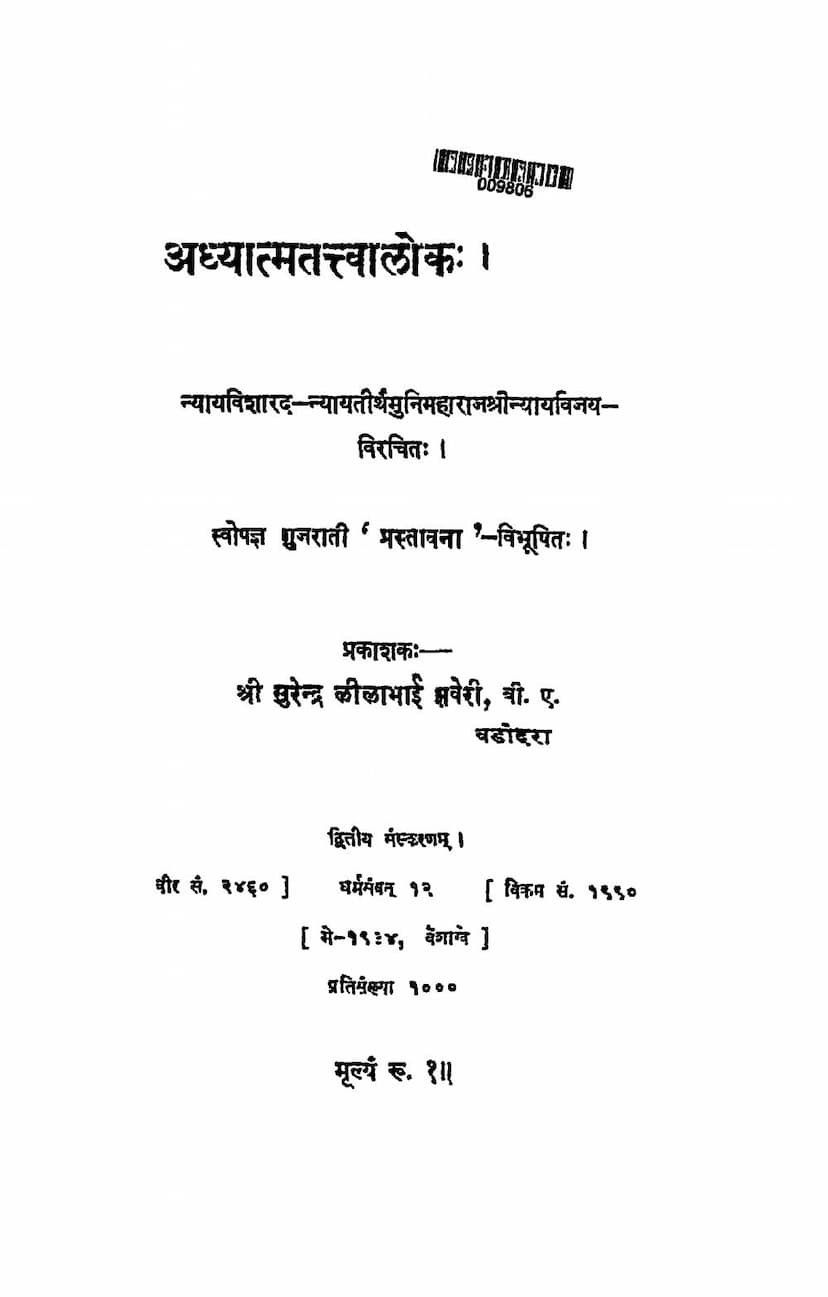Adhyatma Tattvaloka
Added to library: September 1, 2025

Summary
Here's a comprehensive summary of the Jain text "Adhyatma Tattvaloka" by Nyayavijay, based on the provided pages:
The book, "Adhyatma Tattvaloka" (The Light of Spiritual Truth), authored by Nyayavijay, is a significant Jain text that delves into the core principles of spirituality and the path to liberation (Moksha). The text emphasizes the importance of inner purity, right conduct (Sadaachaar), and the understanding of the true nature of the soul (Atma) as the ultimate means to attain happiness and salvation.
Key Themes and Concepts:
- The Pursuit of Happiness: The book begins by acknowledging that happiness is the ultimate goal of all living beings. However, it points out that most people mistakenly believe that material possessions and worldly pleasures lead to true happiness. This is identified as a fundamental illusion (bhram) and a great delusion (mahamithyatva).
- The Illusion of Material Happiness: The author explains that while material comforts may alleviate certain difficulties, they cannot provide lasting or genuine happiness. The pleasures derived from the material world are fleeting and ultimately unsatisfying. The true source of happiness lies within the inner self, the Atma.
- The Importance of Inner Purity (Antahkaran ki Nirdelta): The text stresses that for true happiness to arise, the inner self must be pure and transparent like a crystal glass. This inner purity is achieved by cleansing the mind of negative emotions and vices such as anger (krodh), pride (mad), greed (lobh), lust (trushna), envy (masar), jealousy (irsha), hatred (dwesh), and malice (asuya).
- Sadaachaar (Right Conduct) as the Path: The book asserts that true happiness is found in Sadaachaar, which is defined as the purity of thought and action. This includes virtues like non-violence (ahimsa), truthfulness (satya), self-control (sanyam), renunciation (tyag), and contentment (santosh). A life dedicated to these principles is considered a truly meaningful life.
- The Debate on the Soul (Atma) and God (Ishwar): The text acknowledges the philosophical discussions surrounding the existence of the soul and God. It notes that even those who might be labeled "nasik" (atheists) can still tread the path of righteousness and contribute to their spiritual welfare through virtuous living. The author suggests that true spirituality is not solely dependent on theoretical beliefs but on practical, ethical conduct.
- The Nature of Spirituality (Adhyatma): The book defines Adhyatma as conduct conducive to the welfare of the soul. It underscores that while the ultimate stage of spirituality might be subtle and profound, reaching it requires progressing through various stages of ethical conduct.
- The Role of Karma and Reincarnation: A significant portion of the text discusses the principles of karma and rebirth. It explains how past actions (karma) shape present circumstances and how present actions influence future lives. The text uses examples to illustrate how individual differences in talent, intellect, and fortune can be attributed to past karma and past life impressions (sanskar). It also addresses apparent injustices in the world, suggesting they are resolved through the understanding of karma and rebirth.
- The Proof of the Soul (Atma): The author presents arguments for the existence of the soul, drawing from the evidence of consciousness, the capacity for memory, and the distinction between the senses (instruments) and the experiencer (the soul). The text uses analogies to demonstrate that the soul is distinct from the body and the senses.
- The Path to Liberation (Moksha): The book outlines the yogic path to liberation, which involves the eight limbs of yoga (Ashtanga Yoga): Yama (ethical restraints), Niyama (observances), Asana (postures), Pranayama (breath control), Pratyahara (withdrawal of senses), Dharana (concentration), Dhyana (meditation), and Samadhi (absorption).
- The Eight Limbs of Yoga and Their Significance: Each of the eight limbs is explained in detail, highlighting their importance in purifying the mind and body, and ultimately leading to self-realization. The text emphasizes the principles of non-violence, truthfulness, celibacy, non-possession, and the control of passions.
- The Importance of Guru (Spiritual Teacher): The text venerates the role of the Guru, including parents, elders, scholars, and enlightened beings, as guides on the spiritual path. It stresses the importance of respecting and serving them as essential steps towards spiritual progress.
- Meditation (Dhyana) and its Stages: The book elaborates on the practice of meditation, emphasizing the need for a calm and focused mind, achieved through the practice of concentration and withdrawal of the senses. It describes various stages of meditation and the gradual purification of consciousness.
- The Nature of True Happiness: The text consistently returns to the idea that true happiness is an inner state, independent of external circumstances. It contrasts the fleeting pleasures of the world with the eternal bliss of the soul.
- The Significance of the Present Moment: The book urges readers to seize the present moment for spiritual practice, as the body is impermanent and the future is uncertain.
- Universal Principles: The author advocates for a life of virtue, compassion, and service to humanity, transcending differences of creed, caste, or status. The ultimate message is one of self-realization and universal well-being.
In essence, "Adhyatma Tattvaloka" serves as a guide for spiritual aspirants, providing a profound philosophical and practical framework for understanding the self, overcoming worldly attachments, and ultimately achieving the state of ultimate liberation and bliss. The text is rich in its use of analogies and its logical progression of arguments to lead the reader towards spiritual enlightenment.